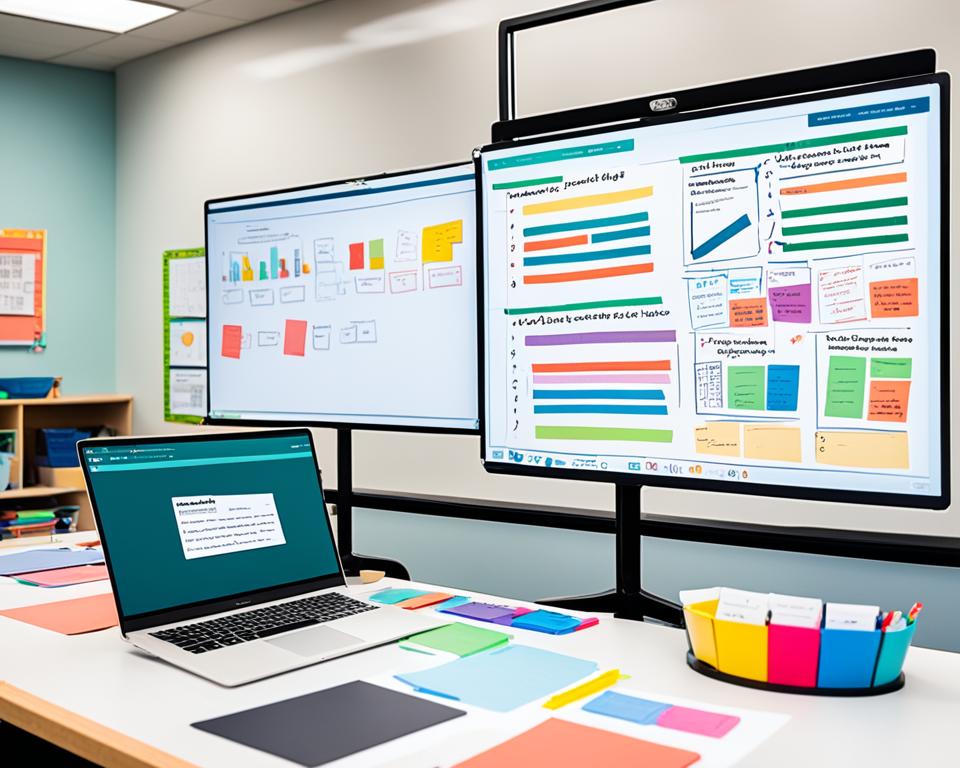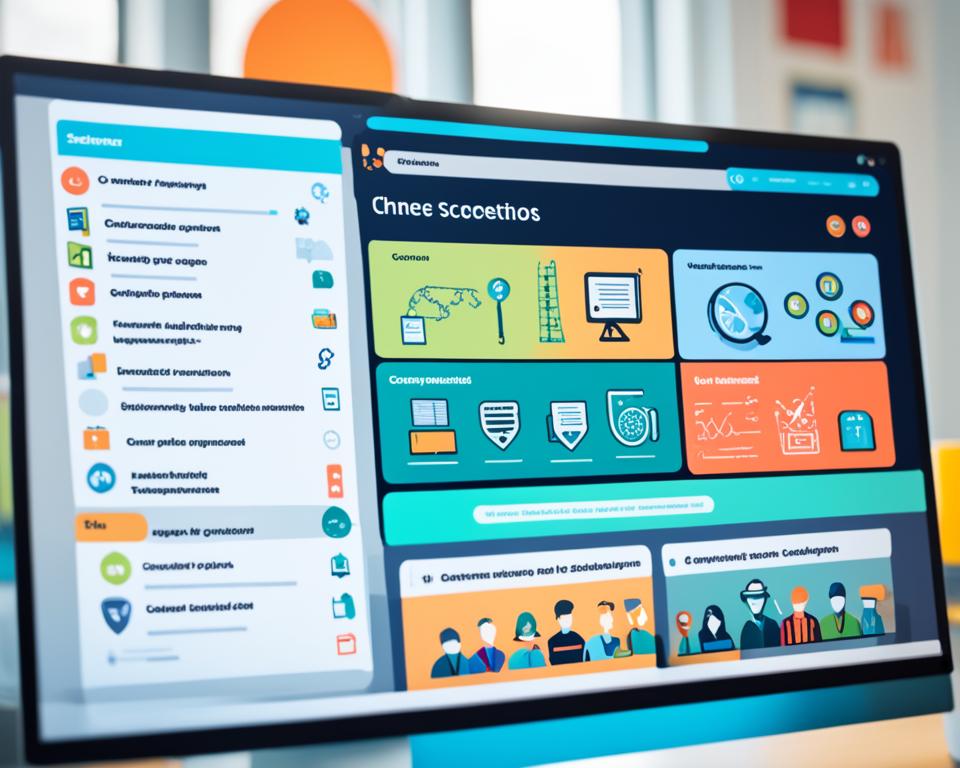As the new school year begins, it is crucial to have policies in place that support online learners and educators. The abrupt shifts to remote learning have negatively impacted students’ well-being and academic achievement, especially those from disadvantaged communities. In-person learning has been shown to lead to better academic outcomes, student engagement, attendance rates, and social-emotional well-being. The U.S. Department of Education emphasizes the importance of implementing science-based strategies to prevent the spread of COVID-19 in schools, such as vaccination, universal masking, contact tracing, ventilation improvements, and physical distancing. These strategies should be incorporated into policies to ensure safe and effective online learning experiences for all students.
Key Takeaways:
- Implement policies that prioritize in-person learning whenever possible while taking necessary COVID-19 prevention measures.
- Address curriculum design, assessment, student support, faculty development, and evaluation in remote learning policies.
- Conduct a needs assessment and review existing policies to inform the development of new online learning policies.
- Draft policies using clear language, examples, and scenarios that align with the institution’s mission and values.
- Validate and test policies through feedback, consultation, and real-life implementation experiences.
Prioritizing In-Person Learning and Preventing Outbreaks
To support online learners and educators, it is crucial to prioritize in-person learning whenever possible while taking necessary precautions to prevent COVID-19 outbreaks. The Centers for Disease Control and Prevention (CDC) recommends implementing layered prevention strategies, including vaccination, universal masking, contact tracing, ventilation improvements, and physical distancing.
Schools that have consistently implemented these strategies have shown lower or similar levels of transmission compared to their communities. By prioritizing in-person learning and implementing these strategies, schools can provide a safe and effective learning environment for students.
The Importance of In-Person Learning
In-person learning offers numerous benefits that online education cannot fully replicate. It allows students to interact directly with their peers and teachers, fostering social and emotional development. Additionally, face-to-face instruction enables immediate feedback, personalized support, and increased student engagement.
By returning to in-person learning, students have the opportunity to reap these benefits and achieve better academic outcomes. However, it is crucial to balance the benefits of in-person learning with the need to prevent COVID-19 outbreaks.
Layered Prevention Strategies
The CDC advises schools to implement layered prevention strategies to minimize the risk of COVID-19 transmission within educational settings. These strategies work together to provide multiple lines of defense against the virus. Key prevention strategies include:
- Vaccination: Encouraging eligible individuals, including students, teachers, and staff, to get vaccinated against COVID-19.
- Universal masking: Requiring everyone, regardless of vaccination status, to wear masks indoors to reduce the spread of respiratory droplets.
- Contact tracing: Implementing robust contact tracing protocols to quickly identify and isolate individuals exposed to the virus.
- Ventilation improvements: Enhancing indoor ventilation to increase airflow and reduce the concentration of virus particles.
- Physical distancing: Maintaining physical distance between individuals to minimize close contact and reduce the risk of transmission.
By implementing these layered prevention strategies, schools can create a safe environment that prioritizes in-person learning while minimizing the risk of COVID-19 outbreaks.
| Key Prevention Strategies | Benefits |
|---|---|
| Vaccination | Reduces the risk of severe illness and hospitalization |
| Universal masking | Prevents the spread of respiratory droplets |
| Contact tracing | Identifies and isolates individuals exposed to the virus |
| Ventilation improvements | Increases airflow and reduces concentration of virus particles |
| Physical distancing | Minimizes close contact and transmission |
Implementing these prevention strategies collectively offers a comprehensive approach to keeping students, teachers, and staff safe while fostering a conducive environment for in-person learning.
Strategies for Effective Learning During Temporary Remote Periods
In situations where students are temporarily unable to attend school in-person and remote learning is implemented, it is essential to have policies in place that ensure seamless online learning experiences. These policies should address key areas such as curriculum design, course delivery, assessment, student support, faculty development, and evaluation. By providing guidelines and support for these aspects, educators can effectively engage students and maintain the continuity of learning during temporary remote periods.
Curriculum Design
A well-designed curriculum is crucial for online learning continuity. It should be flexible and adaptable to accommodate different learning environments. Educators can incorporate multimedia elements, interactive activities, and real-world examples to enhance student engagement and understanding.
Course Delivery
Determining the most effective delivery methods for online courses is essential. Educators can utilize a combination of synchronous and asynchronous learning activities to cater to different learning styles and schedules. Interactive tools and platforms can facilitate collaborative discussions and engagement among students.
Assessment
Effective assessment strategies in remote learning environments ensure that students’ progress is accurately measured. Educators can utilize a variety of assessment methods, such as quizzes, assignments, projects, and online discussions, to evaluate students’ understanding and mastery of the curriculum.
Student Support
Providing ongoing support to students is essential during remote learning periods. Educators can establish communication channels, such as discussion boards or virtual office hours, to address student questions and concerns. Additionally, online tutoring services or peer mentoring programs can offer additional assistance and guidance.
Faculty Development
Supporting faculty members in adapting to online teaching is crucial for effective remote learning. Professional development programs can equip educators with the necessary skills and knowledge to navigate the digital learning landscape. Collaboration and sharing best practices among faculty can also foster a supportive learning community.
Evaluation
Regular evaluation of online learning policies and practices is necessary to ensure their effectiveness. Collecting feedback from students, faculty, and other stakeholders can provide valuable insights for improvement. Utilizing assessment data and analytics can help identify areas of strength and areas that require further attention.
| Key Strategies | Benefits |
|---|---|
| Flexible curriculum design | Enhanced student engagement and understanding |
| Blended delivery methods | Accommodation of diverse learning styles and schedules |
| Varied assessment methods | Accurate measurement of student progress |
| Accessible student support | Addressing student questions and concerns |
| Ongoing faculty development | Empowerment of educators in online teaching |
| Data-driven evaluation | Identification of areas for improvement |

Needs Assessment and Policy Development
Before developing comprehensive online learning policies, conducting a thorough needs assessment is crucial. This process involves gathering and analyzing data from various sources, including surveys, interviews, focus groups, course evaluations, accreditation standards, and existing institutional policies. By examining the online learning context and understanding its specific needs and challenges, policymakers can create effective policies that address these requirements and promote best practices.
One vital aspect of the needs assessment is stakeholder consultation. Engaging with faculty, staff, students, and administrators provides valuable insights and feedback on the current state of online learning. By involving these key stakeholders, policymakers can gain a comprehensive understanding of the strengths, weaknesses, and potential improvements required within the online learning environment.
Ultimately, the data collected through needs assessment and stakeholder consultation serves as the foundation for developing robust online learning policies. These policies can effectively address the needs and challenges identified, ensuring that the institution can meet the expectations of its online learners and educators.
Take a look at this data visualization to see the key steps involved in the needs assessment and policy development process:
| Steps | Description |
|---|---|
| Data Collection | Gather relevant data from surveys, interviews, and focus groups to understand the online learning context. |
| Data Analysis | Analyze the collected data to identify the specific needs and challenges of online learners and educators. |
| Stakeholder Consultation | Engage with faculty, staff, students, and administrators to gain insights and feedback on the current state of online learning. |
| Identify Best Practices | Based on the needs assessment findings, identify best practices from institutions and experts in the field. |
| Policy Development | Develop comprehensive online learning policies that address the identified needs and challenges. |
| Review and Feedback | Review the drafted policies and seek feedback from stakeholders for further enhancements. |
| Policy Implementation | Implement the finalized policies and communicate them effectively to all stakeholders. |
Reviewing Existing Policies and Benchmarking
section plays a crucial role in the development of effective online learning policies. By reviewing existing policies and benchmarking against them, institutions can ensure that their policies are comprehensive and aligned with industry standards. This section explores how existing policies serve as a reference point, identifies gaps, overlaps, and inconsistencies, and highlights the importance of analyzing the policies of other institutions offering online learning.
When developing online learning policies, it is essential to review existing policies that apply to online learning activities. This includes examining both institutional and departmental policies to gain a comprehensive understanding of the current state of online learning. Existing policies serve as a valuable reference point and can provide insights into best practices and areas for improvement.
During the review process, it is crucial to identify any gaps, overlaps, or inconsistencies in the existing policies. This evaluation ensures that the new policies address all necessary areas and do not duplicate or contradict existing regulations. By addressing these issues, institutions can create streamlined and cohesive policies that are effective in supporting online learners and educators.
Benchmarking against the policies of other institutions offering online learning is also a valuable exercise. By examining how other institutions approach online learning, valuable insights and learning experiences can be gained. This benchmarking process allows institutions to understand industry trends, innovative practices, and potential areas for improvement.
| Benefits of Reviewing Existing Policies and Benchmarking |
|---|
| Identify gaps, overlaps, and inconsistencies |
| Ensure policies are comprehensive and aligned with industry standards |
| Gather insights from best practices in other institutions |
| Enhance policy effectiveness and support for online learners and educators |
By carefully reviewing existing policies and benchmarking against other institutions, institutions can develop robust and effective online learning policies. This process ensures that policies are comprehensive, address key areas, and align with industry standards. It also enables institutions to learn from the experiences and practices of others, fostering continuous improvement in online learning.

Next, the article will explore the strategies for drafting clear and concise policies, reinforcing the importance of clarity and alignment with the institution’s mission and values.
Drafting Clear and Concise Policies
After conducting a needs assessment and reviewing existing policies, the next step is to draft clear and concise online learning policies. This process is crucial for establishing a framework that ensures effective implementation and adherence to guidelines.
When drafting the policies, it is recommended to use a template or framework that organizes the policies into categories. This approach enhances clarity and consistency throughout the policy documents. Categories such as curriculum design, assessment, student support, and faculty development can help structure the policies effectively.
The language used in the policies should be clear and straightforward, avoiding jargon and ambiguity. By using plain language, the policies will be easily understandable for all stakeholders involved, including educators, students, and administrators.
Examples and scenarios should be provided within the policies. These real-life situations illustrate how the policies apply in practical contexts, helping stakeholders understand their application and implications. Including concrete examples also helps to minimize misinterpretations and ensures consistent adherence to the policies.
Furthermore, it is essential to align the drafted policies with the department’s mission, vision, and values. This alignment ensures that the policies reflect the overall goals and objectives of the educational institution, providing a cohesive approach to online learning. Additionally, the policies should adhere to relevant laws, regulations, and standards to ensure legal compliance and the promotion of best practices.
| PRACTICAL TIP: | When drafting online learning policies, consider using a clear template or framework to organize policies into categories such as curriculum design, assessment, student support, and faculty development. Use plain language, provide examples and scenarios, and align the policies with the department’s mission and values. |
|---|
Validating and Testing Policies
Before finalizing online learning policies, it is crucial to validate and test them for accuracy, relevance, and feasibility. This ensures that the policies are effective in achieving their intended goals and meeting the needs of online learners and educators. Policy validation involves examining the policies against various scenarios and cases to identify any errors, gaps, or contradictions that may hinder their implementation or effectiveness.
Seeking feedback from stakeholders is a vital step in the validation process. Involving faculty, staff, students, and administrators allows for a comprehensive evaluation of the policies, as they bring different perspectives and experiences to the table. Feedback from stakeholders provides valuable insights, suggestions, and concerns that can be incorporated into the policies, ensuring that they address the unique challenges and requirements of the online learning environment.
Expert consultation plays an important role in validating policies. Consulting with individuals who have extensive experience in online learning policy development and implementation can provide valuable insights and guidance. These experts can offer recommendations based on their expertise, best practices, and lessons learned from previous implementations. Their input helps validate the policies and ensures that they are aligned with industry standards and proven strategies.
Policies should also draw from real-life implementation experience. By examining the outcomes of previous policy implementations, valuable lessons can be learned, leading to the development of practical and effective policies. Real-life implementation experience provides valuable data and insights into what works and what doesn’t, helping to refine and improve policies to meet the specific needs of online learners and educators.
Quote:
“Validating and testing policies is crucial to ensure their accuracy, relevance, and feasibility. By involving stakeholders, seeking feedback, and consulting with experts, policies can be validated and refined to create a supportive and effective online learning environment.”-
Validating and testing policies is an essential step in the policy development process. It ensures that the policies are robust, practical, and aligned with the needs of online learners and educators.

Image: Policy validation is an important step in the policy development process to ensure the effectiveness and relevance of online learning policies.
Implementing and Communicating Policies
Once online learning policies are in place, it is crucial to ensure their successful implementation and effective communication to the online learning community. By following these steps, institutions can promote accessibility, provide necessary training, monitor policy adherence, and ensure ongoing review and updates.
Policy Implementation and Accessibility
Implementing policies involves making them accessible to the online learning community, including students, faculty, staff, and administrators. To achieve accessibility:
- Publish the policies on the department’s website, handbook, syllabus, or other platforms where they are easily accessible.
- Ensure policies are presented in a clear and reader-friendly format, using plain language and avoiding complex jargon.
- Provide multiple language options and accessibility features, such as screen-reader compatibility and captioned videos, to accommodate diverse learners.
Faculty Training and Communication
Proper training and communication are essential to ensure that faculty, staff, students, and administrators fully understand and adhere to the online learning policies. To facilitate effective training and communication:
- Conduct training sessions to familiarize faculty, staff, and administrators with the policies, explaining their purpose, scope, and any specific guidelines.
- Offer ongoing support and resources for faculty to integrate policy requirements into their teaching practices.
- Regularly communicate policy updates or changes to ensure everyone remains informed and up to date.
Monitoring and Enforcement
To ensure policy compliance and maintain a consistent online learning environment, mechanisms for monitoring and enforcing policies need to be established:
- Implement regular checks and audits to monitor policy adherence, such as reviewing online course materials, assessments, and student engagement activities.
- Establish clear procedures for reporting policy violations and addressing any issues that arise.
- Enforce consequences for non-compliance to maintain accountability and foster a culture of policy adherence.
Regular Review and Updates
Online learning policies should be regularly reviewed and updated based on feedback and data collected from online learning activities. This ensures ongoing relevance and effectiveness:
- Gather feedback from students, faculty, staff, and administrators regarding the policies’ effectiveness and identify areas for improvement.
- Analyze data related to policy implementation, such as student performance, engagement, and satisfaction, to inform updates.
- Consult with relevant stakeholders to incorporate their insights and address emerging challenges in the online learning environment.
- Periodically review the policies in light of new technologies, pedagogical advancements, and changing educational needs.
In summary, policies for online learning must be effectively implemented, communicated, monitored, and updated to create an inclusive and supportive online learning environment. By ensuring accessibility, providing faculty training, monitoring policy adherence, and conducting regular reviews, institutions can maintain the integrity and effectiveness of their online learning policies.
Conclusion
In conclusion, implementing effective policies is crucial to support online learners and educators. Prioritizing in-person learning while adopting science-based strategies for preventing COVID-19 transmission is vital. Policies that address curriculum design, assessment, student support, faculty development, and evaluation should be in place to ensure effective learning during remote periods.
A needs assessment, review of existing policies, and validation of new policies are essential steps in policy development. Clear and concise policies aligned with the institution’s mission and values should be drafted and communicated effectively. Ongoing monitoring, enforcement, and regular updates are necessary to ensure the continued success of online learning policies.
By implementing these policies, we can create a supportive and inclusive online learning environment for all.
FAQ
What policies should be in place to support online learners and educators?
Online learners and educators should have policies in place that address key areas such as curriculum design, course delivery, assessment, student support, faculty development, and evaluation. These policies ensure the seamless delivery of online education and support for both learners and educators.
How can in-person learning be prioritized while preventing COVID-19 outbreaks?
In-person learning can be prioritized by implementing science-based prevention strategies such as vaccination, universal masking, contact tracing, ventilation improvements, and physical distancing. These strategies, recommended by the Centers for Disease Control and Prevention (CDC), help create a safe and effective learning environment while minimizing the risk of COVID-19 transmission.
What strategies are important for effective learning during temporary remote periods?
Strategies for effective learning during temporary remote periods include ensuring engaging curriculum design, efficient course delivery methods, appropriate assessment methods, robust student support systems, continuous faculty development, and comprehensive evaluation processes. These strategies help maintain learning continuity and student engagement during remote periods.
What steps are involved in the needs assessment and policy development process?
The needs assessment and policy development process involves collecting and analyzing data from various sources such as surveys, interviews, course evaluations, and institutional policies. Consultation with stakeholders is also critical in gaining insights and feedback. Based on the needs identified, policies can be developed using best practices and tailored to address specific challenges in the online learning context.
How should existing policies be reviewed and benchmarked for online learning?
Existing policies should be reviewed to identify any gaps, overlaps, or inconsistencies that may hinder effective online learning. Benchmarking with policies from other departments or institutions offering online learning can provide valuable insights and learning experiences. This review and benchmarking process help ensure comprehensive and effective policies are developed.
What is the process for drafting clear and concise online learning policies?
Drafting clear and concise online learning policies involves using a template or framework to organize policies into categories such as curriculum design, assessment, student support, and faculty development. Policies should use clear language, avoid jargon, and provide relevant examples and scenarios. They should also align with the department’s mission, vision, values, and adhere to relevant laws, regulations, and standards.
How can online learning policies be validated and tested?
Online learning policies can be validated and tested by checking them against various scenarios and cases to ensure accuracy, relevance, and feasibility. Feedback from stakeholders such as faculty, staff, students, and administrators is crucial in incorporating their suggestions and concerns. Consulting experts or peers with experience in online learning policy development and implementation can also provide valuable insights.
How should online learning policies be implemented and communicated?
Implemented online learning policies should be made available and accessible to the online learning community. This can be done by publishing the policies on the department’s website, handbook, syllabus, or other platforms. Communication and training sessions should be conducted to ensure stakeholders understand and can follow the policies effectively. Mechanisms for monitoring and enforcing the policies should also be established.
What is the importance of regular policy review and updates?
Regular review and updates of online learning policies are necessary to ensure their ongoing relevance and effectiveness. Feedback and data collected from online learning activities should inform these updates. By keeping the policies up to date, educational institutions can continuously improve the online learning experience for both learners and educators.





